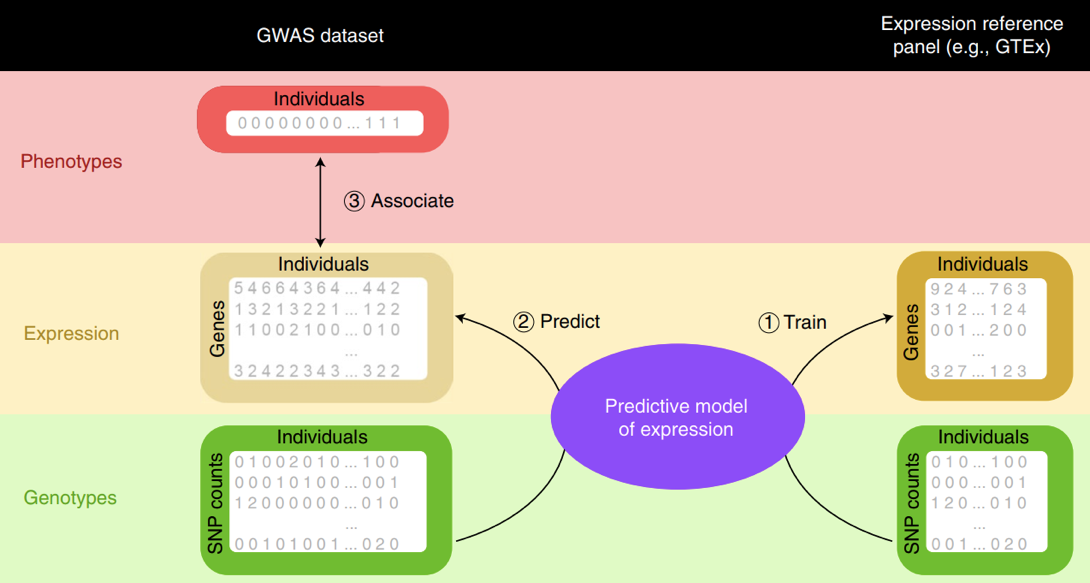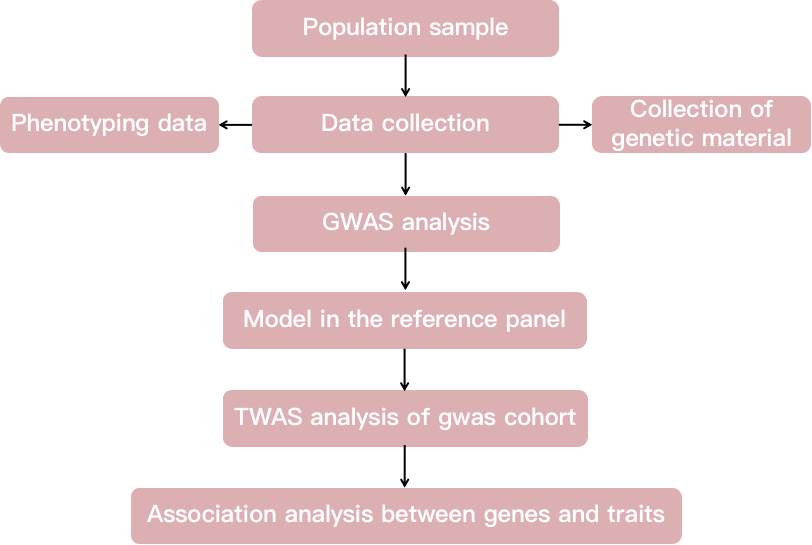TWAS Analysis
Introduction
Genome-wide Association Studies (GWAS) have identified thousands of genetic variants associated with many complex features. However, their biological mechanisms are still largely unknown. The recently proposed transcriptome-wide association studies (TWAS) is a valuable tool for studying the underlying gene regulatory mechanisms associated with variant traits. Specifically, TWAS integrates GWAS and an expression profile study based on a set of common mutations, aiming to determine its GReX and phenotype-related genes. Various methods or software (such as PrediXcan, S-prediXcan, Fusion, UTMOST) have been developed to perform TWAS comprehensive analysis. In order to solve different biological problems, each analysis method or software has different modeling assumptions. In biomedical research, TWAS has been successfully applied to a variety of diseases, such as schizophrenia, breast cancer, prostate cancer, low-density lipoprotein cholesterol and Crohn's disease.
 Fig 1. An overview of transcriptome-wide association studies. (Wainberg, M, et al. 2019)
Fig 1. An overview of transcriptome-wide association studies. (Wainberg, M, et al. 2019)
Advantages of TWAS Analysis
Compared with genome-wide association study, the TWAS research strategy has the following advantages:
- The analysis results are presented in the form of specific genes instead of SNPs in GWAS analysis results. The biological significance of genes is more direct, which is convenient for subsequent functional research and result transformation.
- Compared with GWAS (SNP-based), gene-based analysis has lower multiple comparison pressure.
- Increasingly mature AI analysis methods are used in TWAS research, and the prediction results are becoming more and more accurate.
- The GTEx database has provided extremely rich and transcriptome and genome data.
- Researchers can use a variety of human cell and tissue data as a reference panel to build models. The transition from genome-wide association to transcriptome-wide association can be achieved without additional sample testing.
Applications
The main applications of TWAS analysis in biomedical are:
- Disease warning, early diagnosis, genetic counseling, risk assessment and drug selection.
- Research on susceptibility genes for complex diseases and tumors.
- Analysis of special traits of animals.
What We Offer
As one of the global biological information analysis service providers, CD Genomics provides established, cost-efficient, and rapid turnaround analysis services for TWAS analysis for researchers, aiming to help you understand the relationship between disease or individual phenotype and genotype. CD Genomics provides different software such as PrediXcan, S-prediXcan, Fusion, UTMOST, and other cutting-edge analysis software to perform whole TWAS analysis for customers to meet the analysis needs of different research directions. In addition, we can use various formats of data for analysis such as raw data files, or other intermediate data formats (such as GWAS analysis result file). We will be responsible for all the follow-up matters of the project, and finally provide you with a complete and easy-to-interpret analysis report.
Data Analysis Technical Route
 Fig 2. Flow chart showing TWAS analysis.
Fig 2. Flow chart showing TWAS analysis.
An Example of TWAS Analysis Process
Key steps of TWAS analysis:
1.Training a predictive model of expression from genotype on GTEx (a reference panel);
2.Using above model to predict expression for individuals in the GWAS cohort;
3. Associating this predicted expression with the trait.
Data Ready
Before data analysis, the first thing is to get your data ready. For TWAS analysis, the input data is the same as the GWAS data, includes phenotypic data and genetic data, and the upload data can be obtained from following channels:

To process data more efficiently, we prefer to receive data files in the raw format, but we can also accept pre-normalized files. More importantly, there are currently many databases related to different diseases or SNPs. We are able to provide services for obtaining and mining data from available databases. Alternatively, if you do not currently have the genetic input data, CD Genomics can also provide you with a variety of microarray or sequencing services based on its rich experience. If you have any questions about the data analysis cycle, analysis content and price, please click online inquiry.
What's More
Biomedical-Bioinformatics, as a division of CD Genomics, provides a one-stop transcriptome-wide association analysis service for biomedical researchers. With years of experience in biological data analysis, CD Genomics' analysis engineers will provide you with the most appropriate analysis strategy based on your data, and generate high-quality results and charts that can be used for publication. In addition to TWAS analysis, we also provide GWAS analysis services. For more detailed information, such as microarray or sequencing services and other data analysis services, please feel free to contact us.
References
- Wainberg, M, et al. Opportunities and challenges for transcriptome-wide association studies[J]. Nature Genetics, (2019). 51(4), 592-599. doi:10.1038/s41588-019-0385-z.
- Gusev A, et al. Integrative approaches for large-scale transcriptome-wide association studies[J]. Nature Genetics, (2016). doi:10.1038/ng.3506.
* For research use only. Not for use in clinical diagnosis or treatment of humans or animals.
Online Inquiry
Please submit a detailed description of your project. Our industry-leading scientists will review the information provided as soon as possible. You can also send emails directly to for inquiries.
